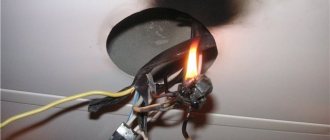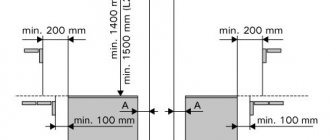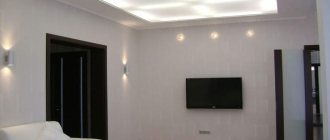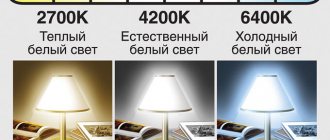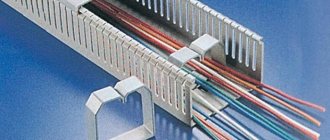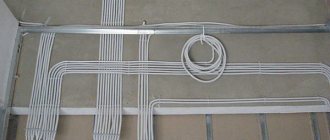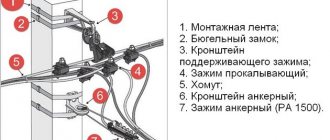The increase in the number of fires at industrial and civil facilities has led to the creation of a number of fire safety measures. The main document is Federal Law No. 123 of 2008. This regulation is supported by a number of technical standards, such as GOST R 53315-2009. This document classifies cable products and defines their use depending on their design. So, in facilities with high fire safety requirements, fire-resistant cable must be used in all electrical circuits. It is distinguished from other modifications by its design.
Scope of application
At industrial and civil facilities with increased requirements for fireproof safety cables, fire-resistant cable is used:
- in SOUE warning schemes;
- in security and fire alarm systems OPS;
- in automated fire extinguishing systems AUPT;
- in ventilation and other systems.
The principle approach is to ensure that the electrical network can support the safe evacuation of people within a specified time. The deadlines are set depending on the scale and layout of the building or structure.
Important! Fire resistance calculations and selection of materials must be carried out at the design stage. Here it is necessary to provide for all safety measures for people, the functioning of systems and equipment. The evacuation interval is taken as a constant, but it must be increased to account for unforeseen situations.
Manufacturers offer various types of fire-resistant cables
Design Features
A fire-resistant cable consists of several elements, each of which has its own characteristics:
- Veins. Wires of this type use copper conductors, the cross-section of which varies from 0.2 to 2.5 mm2.
- Insulation. It is this element that makes the cable fire resistant. Silicone rubber is usually used. Under the influence of fire, it turns into a shell of coke, which continues to perform its functions after the fire. The ceramic-forming material is resistant to mechanical stress and vibration.
- Twisting. The strands are twisted in pairs with a specific color identification. There can be many pairs.
- Screen. This is laminated aluminum foil. It is protection from extraneous electromagnetic waves, and, therefore, from false reactions. The screen is equipped with a contact conductor made of copper wire, which continues to maintain functionality even in the event of a foil break. It is laid from below. There are wires without shield, such as KnCHr (A)-FRHF.
- Shell. Mostly it is PVC with low smoke emission and gas formation characteristics. This is a standard cable element, it protects the wiring from mechanical damage.
This fire-resistant cable product can have any configuration: 1x2x0.5, 1x2x0.64, 1x2x0.75, 1x2x0.98, 2x1.5, 2x1.5, 3x1.5, 1x2x0, 2x2x0, 3x1 and others.
Standard Fire Resistant Electrical Wiring Design
On a note! For particularly critical facilities, for example, medical institutions, a special modification BPTHr(A)-FRLS has been developed. Its cores have a cross-section from 1.5 to 6.0 mm2. It can work for 3 hours at an alternating voltage of 660 V. This brand is used in fire extinguishing and fire ventilation systems.
Fire resistance as the main parameter
This characteristic is defined in the labeling by the designation FR. It shows the time during which the wiring remains operational at a certain fire temperature, type of gasket, operating voltage. The best indicator is marked PO1, which means that the wire will function for 3 hours. Watch fire-resistant cable tests in this video:
This parameter has another important characteristic - fire resistance limit. This is the period of time after which one of the signs of loss of performance appears, for example, a short circuit. Tests are carried out in accordance with GOST R IEC03. The fire is supplied from a gas burner, its temperature should be +750 degrees C. Electricity with a voltage of 300 V is supplied through a horizontally located fire-resistant cable. If the functionality is maintained for 180 minutes, the testing is considered successful.
Note! The term “non-flammable cable” is often used in everyday life. Mostly it denotes wiring that does not spread fire. Another term can refer to products with a fire-resistant, fire-resistant or heat-resistant shell. There are no completely non-flammable wires.
Testing of fire-resistant cable products
Decoding the abbreviation
The wire marking contains five letters, but first we should talk about the missing letter A, which indicates the copper strands of the wire. The letters present in the markings are interpreted as follows:
- P - rubber insulating material.
- K - insulation is made of silicone material (silicone).
- G - flexible wire of unarmored type.
- M - fiberglass outer braid. The material is impregnated with heat-resistant silicone varnish or enamel.
The design features of the wire can be seen in the picture below.
RKGM cable
Note! It is more correct to call RKGM a wire rather than a cable.
Smoke formation and gas emission during smoldering and combustion
This indicator is determined by the LS index. Tests are carried out in accordance with the GOST R IEC 61034-2 standard. A loss of light transmission of up to 50% is considered a positive result. Mainly attention is paid to halogens, namely fluorine and chlorine. These toxic substances spread indoors and, in the presence of water vapor, condense into hydrochloric acid. GOST R 53769-2010 sets the maximum permissible values at 140 mg/g. Special modifications with parameters up to 120 mg/g are being developed for kindergartens. Foreign manufacturers supply products that do not contain halogens.
Testing of fire-resistant cable for smoke and gas emission
Three types of fire resistant cables
Today there are three types of fire-resistant cable products on the market:
- Wires with magnesium insulation. They have a metal shell and may contain one or many veins. The space of the tubes is filled with Mg magnesium oxide. High fire safety is achieved by the absence of substances that decompose due to high temperatures and combustion. These products emit minimal amounts of smoke and gas.
- Wiring with glass mica insulating material. That is, they are armored with mica-containing glass tapes, which are wrapped around the conductive wires. Polymer insulation and PVC are laid on top of the tapes. These modifications stably withstand fire at a temperature of +750 degrees C for 3 hours. With high fire resistance, they are protected from mechanical stress.
- Wires insulated with ceramic rubber. This group has the same fire protection parameters as the previous one, but using a different technology. This modification is characterized by good resistance to mechanical stress, low smoke and gas emission indices, resistance to short circuits, and the ability to operate without channels and ducts. VVGNG-FRLS belongs to this group.
Ceramic rubber insulated cable
Varieties
There are two main types, which have certain advantages and disadvantages:
- The fire alarm cable with glass-mica insulation has high fire-resistant characteristics due to the use of special tapes that are resistant to temperature influences. The design consists of conductive elements wrapped in a protective barrier made of glass tape containing mica. Production is associated with some difficulties, manifested in the winding of conductors with a small cross-section and low speed of tape application.
- Fire-resistant power cables are protected in the form of silicone elastomer - thermoplastic rubber that forms a barrier for temperature and electrical insulation purposes. When exposed to high temperatures, the material creates a ceramic, reliable, dielectric layer on the surface of the products, preventing damage to the conductors and preserving the functioning of the connected systems. Manufacturing is carried out in a short time and does not require complex technological steps, since the material is easily applied to the cores.
The FRLS cable has a sheath made of polyvinyl chloride compositions that do not contain halogen components. Products based on special rubber are highly flexible, which ensures easy installation, practically no differences from conventional elements.
Method of laying and operating conditions of fire-resistant wiring
In addition to direct fireproof characteristics, when choosing, you need to take into account the climatic conditions for which the fire-resistant cable is designed: cold, temperate, tropical. The accompanying documents indicate the installation method: indoors or outdoors, the possibility of open placement or through cable channels. Electrical lines cannot always be laid straight; many industrial and civil installations will require numerous bends. This factor also needs to be taken into account when purchasing. For example, fire-resistant PVKV cable can be laid with turns, even at sharp angles. This modification perfectly withstands pressure changes, including sudden ones.
Area of use
Modern developments in technology have ensured greater availability of non-flammable connecting elements, making the scope of their use much wider. Fire-resistant cable has become widespread in the creation of such systems as:
- emergency lighting;
- fire alarm;
- automatic extinguishing of local fires.
International marking
According to international standards, the manufacturer of fire-resistant cable products must include the following information in the certificate:
- degree of fire resistance;
- ability to spread fire;
- volumes of gas formation, specific conductivity of gases and their pH;
- smoke density indicators when testing a sample under specified conditions;
- volumes of halogen-containing gases during smoldering and combustion.
The following abbreviations are accepted in the international system:
- SID - solid 1-component core;
- SIZ – flexible non-flammable cable;
- SIF – wire with thin cores;
- SIFF – modification with super-thin conductors;
- GL – fiberglass heat-resistant braid.
Russian cable products
The Russian market mainly offers products from domestic enterprises, which have their own designations:
- KShM or KShSE – for connecting control and measuring equipment;
- KPS or KPSE – components for warning and fire extinguishing structures;
- KUNRS – for fire protection circuit blocks;
- KSBG – for industrial facilities;
- KSB for connecting automation to equipment and systems;
- PVKV – silicone wires for switching equipment;
- RKGM is a flexible cable without armor.
Russian markings
Electrical wiring in baths and saunas
In baths and saunas, you need to approach the choice of cable products responsibly, since the premises have critical conditions for electrical networks: the temperature is close to +190 degrees C, and the humidity often exceeds 90%. A wrong decision will cause electric shock to people. In the locker room and dressing room it is permissible to install ordinary wires, but in the steam room only special heat-resistant modifications can be used, taking into account the material of the walls. These can be RKGM, PVKV, PRKA, PMTK and their analogues. It is important to take into account not only the temperature and humidity conditions, but also the laying pattern. You should not discount lighting equipment: lamps, sockets and switches.
Heat-resistant wires for saunas and baths
Conclusions and useful video on the topic
The main thing about electrical wiring in a fire-hazardous house:
The correct selection of cable for wiring in a wooden house is the key to the safety of its inhabitants. Due to the increased fire hazard of such a structure, it is necessary to use cable brands with a high degree of reliability .
One should not miss the point that cables and devices should not come into contact with wood. Provided that the wiring is wisely selected and carried out taking into account the recommendations, the efficiency, durability and safety of the wiring can be guaranteed.
Tell us about how you selected a cable to supply a country wooden house with electricity. Share interesting technological nuances that will be useful to site visitors. Please leave comments in the block below, ask questions, post photos on the topic of the article.
Let's summarize
When choosing cable products, you should carefully study their technical parameters, since this is not only an opportunity to pass fire inspections without any questions, but a measure of social responsibility for people’s lives. It is important to accurately identify brands, check for a certificate, and test them in specialized licensed laboratories. And provide for unforeseen situations. Work on project development, selection of components, and installation should be trusted only to professionals who will carry out the work competently and provide them with guarantees.
Stamps
The modern range of connecting and cable products available in stores is represented by a large number of elements with different functions and characteristics. There are both domestic manufacturers producing products such as VVGngd, VVGng FRLS, and foreign brands that provide a wide selection of different options, for example, halogen-free wiring FLAME-X 950, FLAME-X950, as well as N2XH and YnKY.
The products have an average price category, which helps to expand the scope of their use. Cables are capable of ensuring the reliability of both fire systems and other devices in fire conditions.
The materials sold by FireKab are quite widespread; the extensive range is represented by high-quality elements, so there are no difficulties when choosing.
Russian-made products are no less popular, among them the KPSVV line is the leader - it is distinguished by its reasonable cost and high quality, corresponding to foreign standards.
